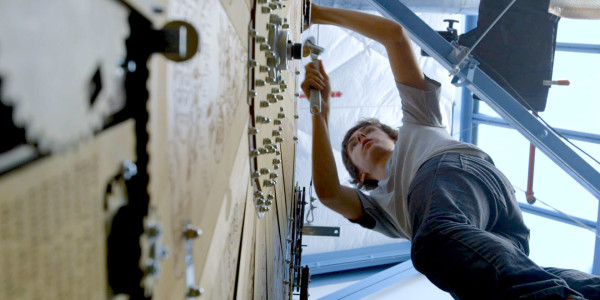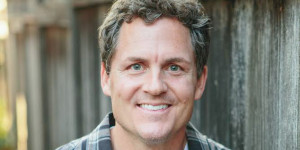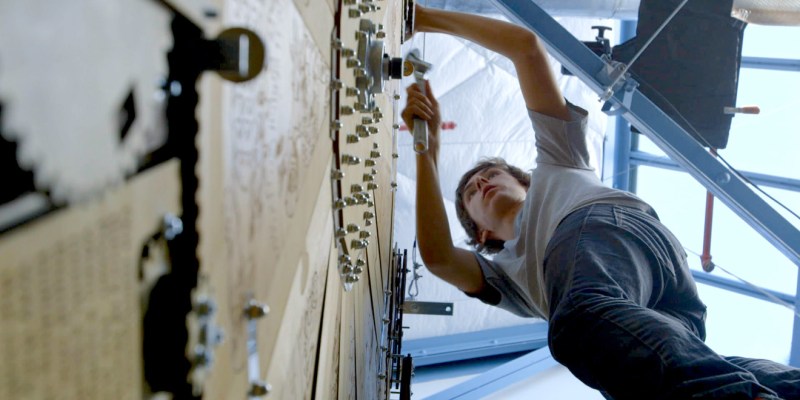
Given that our education system was designed over a century ago by a group of 10 men, including founders of the industrial revolution like Henry Ford, is it still serving students of the 21st century well? This is the central question of Greg Whiteley’s new documentary, “Most Likely to Succeed,” which premiered at this year’s Sundance Film Festival. The film excavates the roots of our current education system, argues for how the world is changing in a way that make this form of education obsolete, and looks for answers for the future of education. During the Sundance Film Festival, I sat down with Whiteley and Dintersmith to discuss High Tech High, education reform, and the role that Montessori-type education might play in education for the 21st century.
Working with Stanford alumnus and executive producer Ted Dintersmith, Ph.D. ’81, Whiteley discovered a charter school in San Diego, High Tech High, which is already involved in a revolution in education. Students at High Tech High don’t sit in a classroom, getting lectured by a teacher from 9 a.m. to 3 p.m. Instead, they’re involved in multi-disciplinary, collaborative projects, where learning the physics behind how gears work might be key to completing their social science project on why civilizations rise and fall: They had to build a visual representation of their theories using mechanical systems.
In fact, what’s happening at High Tech High sounded to me a lot like the Montessori method, an educational approach for elementary school students, which emphasizes independent learning and exploration. But no one has yet figured out how to extend the Montessori method into secondary school. As someone who’s a product of a Montessori School — I attended one from kindergarten to grade six, when Montessori ends — who then found being thrown into a regular school system a crushing experience, I was excited to see that High Tech High just might be the answer to providing the Montessori experience to middle school and high school students.
When I asked Whiteley and Dintersmith if they’d explored the Montessori method at all, they noted that it kept coming up during their interviews with the film’s subjects. Whiteley recalled, “One of the key interviews in our film is [with] this economist named Andy McAfee, out of M.I.T. He was a product of Montessori schools. He gave us this great quote, where he tells this story that for the first few years of his life, [he] just developed this keen interest in x, y and z, because [he] was allowed to explore. [He] was allowed to poke at things and kind of learn in a way that Montessori celebrates. And then, because he aged out, or maybe because his parents moved, he went to a more traditional school, and he said, ’it just killed me. It was just so painful.’ ”
Dintersmith added that there was an article in the Wall Street Journal a few years ago about the “Montessori Mafia” — people like Amazon Founder Jeff Bezos, Wikipedia founder James Wales, and Google Co-Founders and Stanford Alumni Larry Page M.S. ’98 and Sergey Brin M.S. ’95 all of whom spent their formative years in a Montessori school. The “Montessori Mafia” found that Montessori was the best education experience of their lives. So, Dintersmith asked, “Why is it in 2015, when the world begs for the characteristics that get promoted in Montessori school, [why do] we send kids to this desert called middle [school], high school and college?”

Whiteley explained that when our current education system was founded, “What we hoped it would produce was a level of obedience and compliance and the ability to follow instructions. During the Industrial Revolution, those characteristics were really helpful. If you were following instructions from a foreman on an assembly line, obedience and compliance meant people were safe. You were efficient. You could mass produce instructions, and build a factory in New York, Ohio, St. Louis, and you’d get a work force no matter where you were, because you’d standardized education — all these people that could read or follow instructions.”
But times have changed, and Whiteley continued, “Compliance, following instructions: those don’t serve us very well in the 21st century. If that’s all you can do, and you show up to a job interview, your employer is going to look at you, and just say, ‘Well, I really don’t need people like that, because I’ve got a computer, or an algorithm, or a piece of software, that is compliant or follows instructions. I need somebody that can come here and think critically, and not just problem-solve, but detect problems. I want you to point out to me problems that I’m not even aware of and solve them.’ That’s what employers in the 21st century are looking for. It’s what life is looking for.”
One of the problems with our current, traditional education system is its emphasis on rote memorization — cramming for a test rather than applying the knowledge you’ve learned to a situation that’s actually useful. Dintersmith described the basis of the current system as a myth: “The [idea] that if you just take notes, memorize, and go back into a class and either recall content or definitions or string pieces of content together, into a formulaic essay, or do low-level procedures, in a science or engineering class, and that you’ve actually learned anything is exactly that: it’s a myth. Which we hope people say [when watching the film], “Wait a minute, what’s going on?”
Whiteley explained that there’s research to back up the claim that this is not the way to educate our children: “Studies show that you might as well be memorizing the phone book, because anything you do learn under those conditions, you’re going to forget three weeks later. And when I say forget, I mean gone forever. There are studies that demonstrate that the content you spent a whole semester trying to learn — all of these facts, dates, into your head, cramming for them — they’re gone, three weeks after you take the test. And that begs the question, ‘What have we been doing?’ And then it begs the second question, ‘What can we do differently?’ How should education change so that it isn’t something that’s just disposable, and move onto the next thing?”
This is especially a problem within Science, Technology, Engineering, and Mathematics (S.T.E.M.) education. Whiteley noted that “We’ve been conditioned to believe that a good math student is someone who is graduating, like you would get certain merit badges. You now have algebra as a part of your toolkit. You now have calculus. And as you graduate along, two problems. One, you’re learning it in this traditional way, where you forget it three weeks later, so you’re not really building on it. The second thing is you’re not taking that math and applying it in any real way.”
“As Linda Darling-Hammond, [an education professor] at Stanford [notes]” whom Whiteley interviewed in the film, “and has done really important research on this subject and cites others, as well — there’s a part of your brain, that when you take something that you’ve learned, particularly math, and you get it, and you’re asked to apply it—Or better, if you’re working on something you love, and you go, ‘You know, I could use some math here to help me solve it.’ Or a teacher points out that if you learn this element of calculus, that’s going to help you solve this little problem that you’re working on here. Then, that math that you go and learn, you learn it much faster. And it gets stored in your brain in a place that it doesn’t become disposable. They’ve tested this. It’s there later, and you then start to build on it.”
When Whiteley interviewed Eric Mazur, a physics professor at Harvard, Dintersmith recalled that Mazur “concluded nobody was learning physics at Harvard. All they’re learning is to memorize formulas, shove numbers in, and not make a mistake on units or the math. And so his [class] is entirely different, where he delivers thought-provoking conceptual questions.” One of these questions, that Mazur and is a thought experiment where, Dintersmith recounted, “[you’ve got a] rectangular sheet of copper, uniform thickness. [You] cut a hole in the center the size of a quarter, [and] heat it up — heat it uniformly. What happens to the size of the hole? Gets bigger? Stays the same? Gets smaller?”
Only 10–20 percent of Mazur’s students get it right, and even when he tried the thought experiment on employees at Google’s Cambridge, Massachusetts campus — “people that you know have gotten fives on all their AP tests,” Dinersmith added — there was a random, even split in the room: one third of the people in the room thought it would get bigger, one third thought it would get smaller, and one third thought it would stay the same. Dintersmith said he’s now asked at least 300 people this question, and the only people who always get it right are “electricians, plumbers [and] emergency medical technicians (EMT),” because it’s a principle they’ve actually had to apply on the job. For example, if you’re an EMT with a patient who has a swollen finger with a metal ring on it, you heat the ring to get it off.
Dintersmith added, “We think we’re teaching kids how the world works when we teach them science, but nothing could be further from the truth.” Whiteley continued, “[It’s] pretty good evidence that we’re turning kids off from science. Because you look at it, and it’s like, is this what science is? It’s memorizing a bunch of stuff? It’s all theory.” Yet this isn’t the case at High Tech High, where about a third of their graduates who go to college — and almost all of them do — end up studying in S.T.E.M. That’s partly because even when they’re studying history, they still have to use mathematic or scientific principles to build visual displays to present their work. It’s all inter-connected and inter-disciplinary: you can’t self-select out as “not a science person,” because you’ll still have to to deal with science and math in your humanities classes.
High Tech High is not the only place that’s taking a different approach to S.T.E.M. education.“The best high school math I’ve seen,” recalled Dintersmith, “was in a social studies class in a school in Massachusetts. They had the kids work in teams to predict the world’s population in the year 2100. And then it’s transformational. Because these kids suddenly [had] to know about extrapolation, curve fitting. Some of them [wrote] their own code to project it. One group [decided they] were going to segment the world’s population by religion [using Eigenvalues] and [looked] at the systematic growth rates by religion, and [used] that to project forward.”
It completely shifts the paradigm of what math is actually about. Much to Dintersmith’s chagrin, even teachers will say, “ ‘math is different, because there’s only one right answer.’ And what I always say back is that the reason you say that is because you’re not teaching anybody math. You’re teaching them arithmetic or symbolic computation. But you’re not teaching them math modeling, in any way shape or form. So you watch this class where kids now work in groups, come up with [their] assumptions, logically analyze everything, present it and critique it. So [they might end up saying], ‘Wait a minute, you got to 45 billion people in the year 2100? That can’t be right.’ ” Deciding what to put in and keep out of a mathematical model is a fuzzy process, one that doesn’t really have a right answer, but you can know when you’ve gone completely wrong.
The fact that we aren’t properly teaching students to think critically, in S.T.E.M. or otherwise, means we’re not creating people who can be active, thinking citizens of a democracy. Whiteley said, “Even to be a citizen in this country, it’s not enough just to be compliant and obedient. You should be somebody that’s critically thinking of ways that this country can improve, and how you might improve it — how you fit in this democracy. I really believe the success of not just people, economically, but of our future role as leaders in the world, free people, are going to be contingent upon our ability to think critically, have empathy, understand what it means to be [a] part of a team, and to work as a team, [and have] grit. These are things that our schools weed out of kids. They were never designed to produce those kinds of skills. I believe we innately have them. I think if you go into kindergarten, you’ll find many of these skills. Montessori schools have figured that out. They nurture that. The current system does not. We’ve got to figure out a way to change it.”
I suggested that it’s this kind of education system that’s producing citizens who aren’t infuriated about the fact that federal governments — in the U.S., Canada and beyond — are cutting research funding to the pure sciences. Had schoolchildren seen, first-hand, the value of S.T.E.M., they might become better citizens. There was a study done at M.I.T. by Sterman and Sweeney a few years ago, where they asked S.T.E.M. graduate students to explain the basic scientific concepts behind climate change — stock flow principles — and they weren’t able to. You’d think, of all people, they would be the ones to ask. But if these top, advanced S.T.E.M. students didn’t understand the science of climate change, how can the average citizen be expected to understand how climate change works and then become an advocate for aggressive environmental policies? When I proposed this to Whiteley, his response was, “Exactly. We should have put you in the film.”
It’s for all of these reasons — the need to produce creative individuals, who love learning, who can contribute creatively to society — that Whiteley has picked up and moved his family to San Diego where both his kids now attend High Tech High. Whiteley does caution though that “High Tech High is not this panacea. They’re not perfect. I think I would be the first to tell you. I don’t think they’re for everybody. I’ve got a boy and a girl, and they’re really different. Both of them happen to love High Tech, particularly when it’s done right. So [both of them] have had teachers, whom I’m convinced are as good as you can be. When it works, the happiness that you feel emanating from them, just a human being that is coming into their own, makes me cry just to think about it. It’s so fun to watch. But it’s just as dark when it’s somebody who’s not up to speed. It’s just as discouraging. They’ve had both of those experiences in the last year-and-a-half we’ve been there.”
Nevertheless, there’s hope that the hands-on, multi-disciplinary teaching methods of High Tech High could be applied elsewhere. This is a school where teachers are brought in, Whiteley explained, “on one year contracts: no tenure, not a lot of job security. You make slightly less money when you start out at High Tech High [than at other public schools]. In spite of that, they’ve got a five year waiting list.” And not all of the teachers at High Tech High even have training as educators, but they’re put through a rigorous application process to screen for teaching ability. This suggests that it might not be as hard as we might think to find enough of these teachers to serve all the schools in the U.S. But it won’t happen unless we start to critically examine our current education system, where it goes wrong, and what we should be doing differently. It’s the hope of Whiteley and Dintersmith that “Most Likely to Succeed” will be a major catalyst for that conversation. It’s certainly gotten me thinking.
Contact Alexandra Heeney at aheeney ‘at’ stanford.edu
